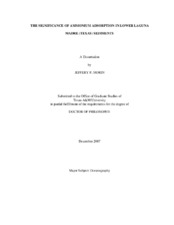| dc.contributor.advisor | Cifuentes, Luis | |
| dc.creator | Morin, Jeffery Peter | |
| dc.date.accessioned | 2010-01-15T00:03:33Z | |
| dc.date.accessioned | 2010-01-16T00:23:58Z | |
| dc.date.available | 2010-01-15T00:03:33Z | |
| dc.date.available | 2010-01-16T00:23:58Z | |
| dc.date.created | 2007-12 | |
| dc.date.issued | 2009-05-15 | |
| dc.identifier.uri | https://hdl.handle.net/1969.1/ETD-TAMU-2099 | |
| dc.description.abstract | The work presented in this dissertation focuses on +
4 NH in marine sediments and
attempts to elucidate some of the specific pathways and processes affecting +
4 NH in
coastal marine regions. The majority of work was conducted in the Laguna Madre
estuary. A major feature of the estuary is the Gulf Intracoastal Waterway (GIWW)
connecting the Lower Laguna Madre to Baffin Bay. Establishment of the GIWW has
altered the hydrodynamics of the estuary, reduced seagrass coverage and increased
sediment mobility resulting in frequent maintenance by the U.S. Army Corp of
Engineers. GIWW sediment relocation associated with dredging is investigated to
determine potential influence of +
4 NH release during resuspension. GIWW sediments
are characterized by extremely high concentrations of porewater and exchangeable +
4 NH
as well as reducing ions (millimolar HS-), and significant release hours to days after
resuspension was observed during laboratory experiments. Using sediment +
4 NH
porewater and exchangeable quantities, release potentials are calculated for a dredging
event conducted in 1989 and results indicate that potential release from the dredging
event are comparable to monthly inputs from intact GIWW and seagrass sediments. Reducing condition influence on +
4 NH adsorption dynamics was tested through
resuspension experiments over a wide range of initial bulk concentrations in laboratory
determined redox conditions. Significant increase in +
4 NH adsorption was observed in
anoxic conditions. Calculations of the apparent partition coefficient (K*) were
determined to be affected as well and implications to diagenetic models is explored.
Observations in the laboratory were tested in field monitoring. Analysis of wind
measurements established strong potential for interaction with sediments over the
collection period. Measurements of water column +
4 NH , total suspended solids, and
chlorophyll exhibited highest concentrations and correlation in areas close to the GIWW.
Concentration measurements were combined with flux measurements in a model system
designed to integrate field observations. Several model cases were considered including
and excluding sediment resuspension. Model simulations including sediment
resuspension maintained water column concentrations similar to field observations. | en |
| dc.format.medium | electronic | en |
| dc.format.mimetype | application/pdf | |
| dc.language.iso | en_US | |
| dc.relation.uri | https://hdl.handle.net/1969.1/85863 | |
| dc.subject | Ammonium | en |
| dc.subject | Adsorption | en |
| dc.subject | Nitrogen | en |
| dc.subject | exchangeable | en |
| dc.title | The significance of ammonium adsorption on lower laguna madre (texas) sediments | en |
| dc.type | Book | en |
| dc.type | Thesis | en |
| thesis.degree.department | Oceanography | en |
| thesis.degree.discipline | Oceanography | en |
| thesis.degree.grantor | Texas A&M University | en |
| thesis.degree.name | Doctor of Philosophy | en |
| thesis.degree.level | Doctoral | en |
| dc.contributor.committeeMember | Davis, Stephen | |
| dc.contributor.committeeMember | Jackson, George | |
| dc.contributor.committeeMember | Slowey, Niall | |
| dc.type.genre | Electronic Dissertation | en |
| dc.type.material | text | en |
| dc.format.digitalOrigin | born digital | en |


